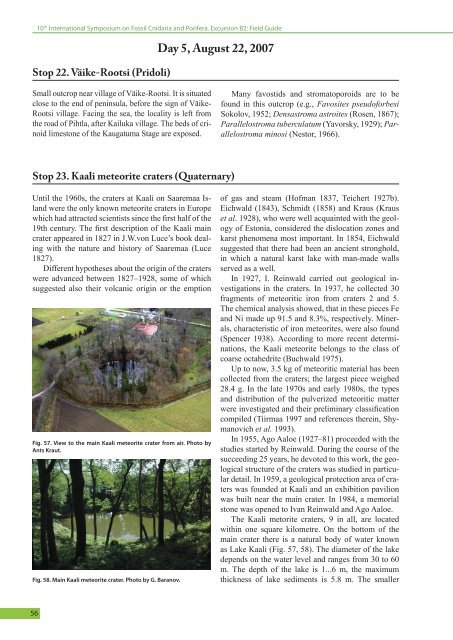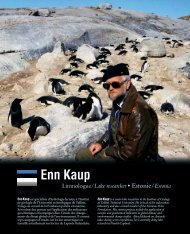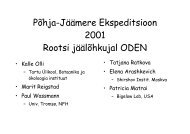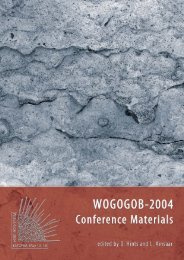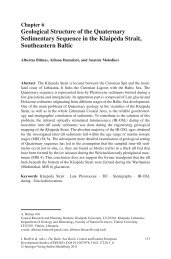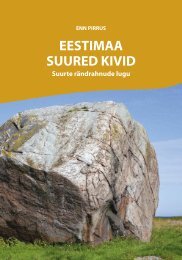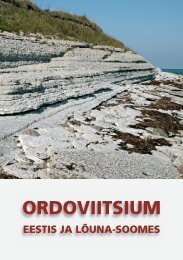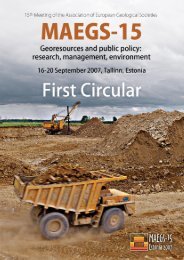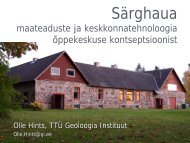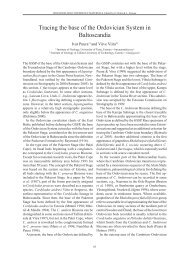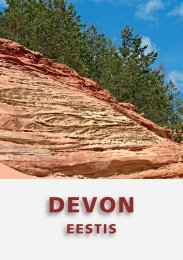10 th International Symposium on Fossil Cnidaria and Porifera. <strong>Excursion</strong> B2: Field GuideStop 22. Väike-Rootsi (Pridoli)Day 5, August 22, 2007Small outcrop near village of Väike-Rootsi. It is situatedclose to the end of peninsula, before the sign of Väike-Rootsi village. Facing the sea, the locality is left fromthe road of Pihtla, after Kailuka village. The beds of crinoidlimestone of the Kaugatuma Stage are exposed.Many favostids and stromatoporoids are to befound in this outcrop (e.g., Favosites pseudoforbesiSokolov, 1952; Densastroma astroites (Rosen, 1867);Parallelostroma tuberculatum (Yavorsky, 1929); Parallelostromaminosi (Nestor, 1966).Stop 23. Kaali meteorite craters (Quaternary)Until the 1960s, the craters at Kaali on Saaremaa Islandwere the only known meteorite craters in Europewhich had attracted scientists since the first half of the19th century. The first description of the Kaali maincrater appeared in 1827 in J.W.von Luce’s book dealingwith the nature and history of Saaremaa (Luce1827).Different hypotheses about the origin of the craterswere advanced between 1827–1928, some of whichsuggested also their volcanic origin or the emptionFig. 57. View to the main Kaali meteorite crater from air. Photo byAnts Kraut.Fig. 58. Main Kaali meteorite crater. Photo by G. Baranov.of gas and steam (Hofman 1837, Teichert 1927b).Eichwald (1843), Schmidt (1858) and Kraus (Krauset al. 1928), who were well acquainted with the geologyof Estonia, considered the dislocation zones andkarst phenomena most important. In 1854, Eichwaldsuggested that there had been an ancient stronghold,in which a natural karst lake with man-made wallsserved as a well.In 1927, I. Reinwald carried out geological investigationsin the craters. In 1937, he collected 30fragments of meteoritic iron from craters 2 and 5.The chemical analysis showed, that in these pieces Feand Ni made up 91.5 and 8.3%, respectively. Minerals,characteristic of iron meteorites, were also found(Spencer 1938). According to more recent determinations,the Kaali meteorite belongs to the class ofcoarse octahedrite (Buchwald 1975).Up to now, 3.5 kg of meteoritic material has beencollected from the craters; the largest piece weighed28.4 g. In the late 1970s and early 1980s, the typesand distribution of the pulverized meteoritic matterwere investigated and their preliminary classificationcompiled (Tiirmaa 1997 and references therein, Shymanovichet al. 1993).In 1955, Ago Aaloe (1927–81) proceeded with thestudies started by Reinwald. During the course of thesucceeding 25 years, he devoted to this work, the geologicalstructure of the craters was studied in particulardetail. In 1959, a geological protection area of craterswas founded at Kaali and an exhibition pavilionwas built near the main crater. In 1984, a memorialstone was opened to Ivan Reinwald and Ago Aaloe.The Kaali metorite craters, 9 in all, are locatedwithin one square kilometre. On the bottom of themain crater there is a natural body of water knownas Lake Kaali (Fig. 57, 58). The diameter of the lakedepends on the water level and ranges from 30 to 60m. The depth of the lake is 1...6 m, the maximumthickness of lake sediments is 5.8 m. The smaller56
10 th International Symposium on Fossil Cnidaria and Porifera. <strong>Excursion</strong> B2: Field Guidecraters, locally known as dry lakes, are shallow hollowsbordered in places with the remains of a lowwall. The craters have formed in the clayey basal tilland underlying thick micro-bedded Upper Siluriandolomites. The main crater measures 105...110 m indiameter at the top of the mound, and is at least 22m deep. The upper part of the mound consists of thematerial ejected from the crater during the explosionand of partly overhanging dolomite layers tilted at anangle of 25–90°. The uplifted bedrock complex withan average thickness of 10 m has been split into nineshifted blocks, each up to 50 m wide (Tiirmaa 1997and references therein).The diameters of the secondary craters range from12...40 m being 1...4 m deep. On the bottom of craters4 and 5 meteorite impact traces have been discovered.The energy at the formation of the Kaali cratershas been estimated at 4x10 19 ergs for the main crater(Tiirmaa 1997 and references therein). Based on themain crater’s energy of formation and the supposedangle of incidence of 45°, the following ranges of valueswere obtained: initial mass of meteorite 400 to10,000 tonnes, mass at impact 20 to 80 tonnes, initialvelocity upon entering the atmosphere 15 to 45 km/s,velocity at impact 10 to 20 km/s. The meteorite piecescausing the small secondary craters separated at an altitudeof approximately 5...10 km, and their combinedmass did not exceed 18 to 20% of the total mass.Opinions differ as to the direction and angle of incidenceof the Kaali meteorite. The sizes of the cratersled the first investigators to believe that the directionof movement was from the southeast to the northwest(Tiirmaa 1997 and references therein). Aaloe, basingprimarily on the study of impact traces at the bottomof craters 4 and 5, maintained that the probable angleof incidence had been 35–40° relative to the horizon(Tiirmaa 1997 and references therein). The morphologyof the wall of the main crater, the geophysicaldata available on the destruction zones of the mainand secondary craters 1 and 6 and the distribution ofdispersed material in the craters and outside the craterfield suggest that the meteorite fell from the eastnortheast(Tiirmaa 1997 and references therein).Various methods have been used to determine theage of the craters. As neither deformed remnants fromthe explosion nor more recent sediments of marineorigin had been found in the crater, Linstow (1919)estimated the age of the crater at about 4000 to 8000years. Since the craters or their embankments did notreveal any traces of marine erosion or accumulation,Reinwald (Tiirmaa 1997 and references therein), basingon the data available on the history of the BalticSea at that time, considered the craters some 4000–5000 years in age. In his first papers, Aaloe expressedthe same opinion, but some years later he maintainedthat the age of the craters could not be more than 3000to 4000 years. 14 C dating of charcoal discovered in1961, yielded an age of 2660±200 years; the later dates2530±130 and 2920±40 years allowed Aaloe to placethe age of the craters erroneously at about 2800±100years (Tiirmaa 1997 and references therein).As it was not excluded that the dated charcoalwas much younger than the craters themselves, greathopes were placed on drilling and dating of lake sedimentsin the main crater. Palynological analysis byKessel (Tiirmaa 1997 and references therein) showedthat the bottommost sediments are Sub-Boreal in ageand the craters are more than 3500 years old. Simultaneous14 C and palynological investigations initiatedby L. Saarse, placed the craters’ age at approximately3500...4000 years (Saarse et al. 1990) or 4000 yearsBP (Saarse et al. 1992).Recent investigations have shown that the Kaaliarea was freed from the waters of the Baltic Sea alreadysome 8000 yr BP. In 1994, a high concentrationof microimpactites was detected in the peat ofthe Piila Bog, about 10 km to the northwest from theKaali craters. The age of the layer with microimpactiteswas established by means of palynological andradiocarbon methods. The studies suggest that theKaali craters were formed probably close to 7500 BP(Raukas et al. 1995a).The mid-1970s witnessed an ever growing interestof historians in the Kaali Crater. Impetus was givenby Lennart Meri’s books “Hõbevalge” (1976) and“Hõbevalgem” (1984) and by the first archaeologicalfinds in the east wall of the main crater in 1976.In 1978, excavations were begun on the discoveredfortification which is located on the outside slope ofthe northeastern wall of the main crater. From theside of the lake it is protected by a steep slope andfrom outside by a semi-circular wall. Archaeologicalfinds in the fortress area are limited, few earthenwarefragments are dated from the 7th century BC, most ofthe pottery dates from the Iron Age, the beginning ofwhich is considered to be 600 years BC locally (Lõugas1978, 1980).57


